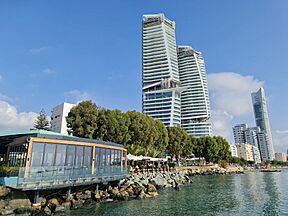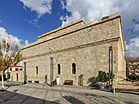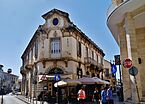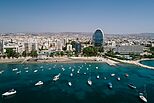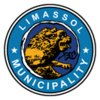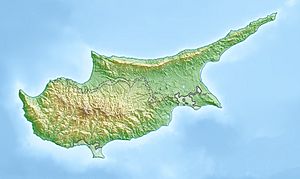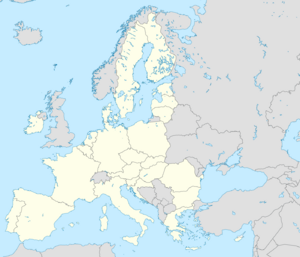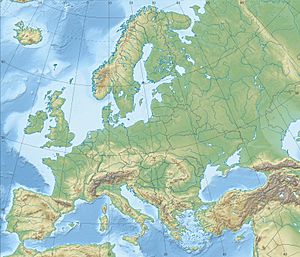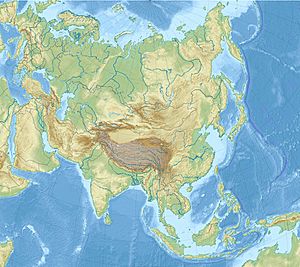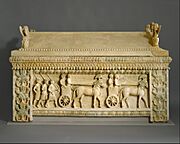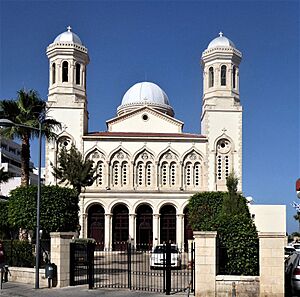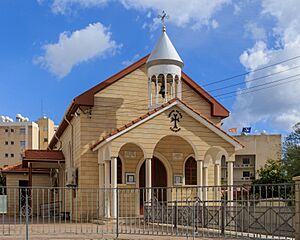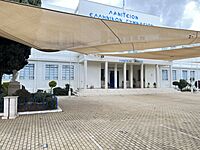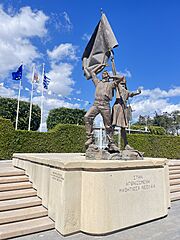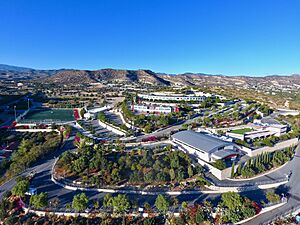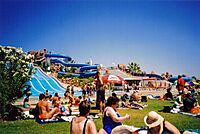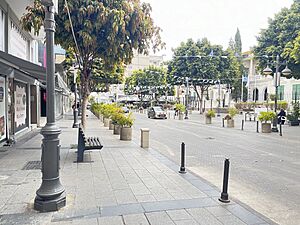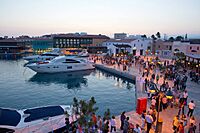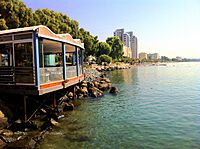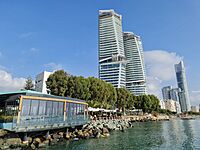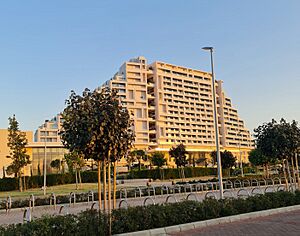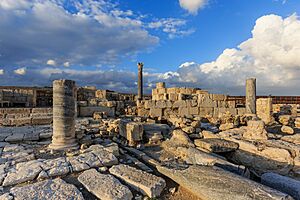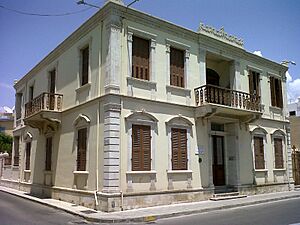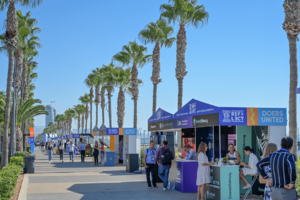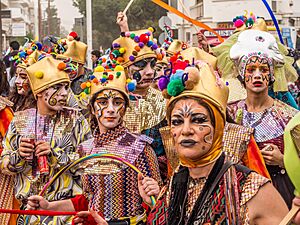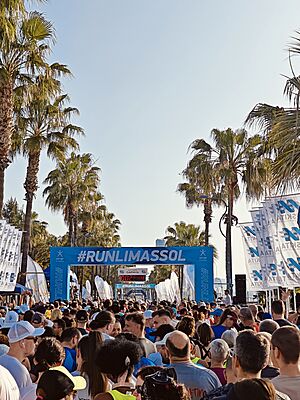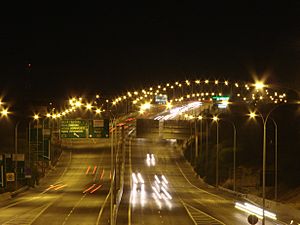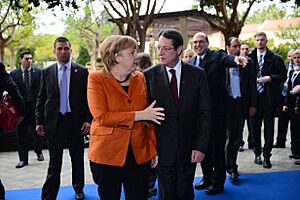Limassol facts for kids
Quick facts for kids
Limassol
Lemesos
|
||
|---|---|---|
|
City and municipality
|
||
|
Trilogy buildings (left) and ONE in the distance
Limassol Castle
Street in the Old Town
Limassol Molos
Limassol Marina
The Oval
City of Dreams
|
||
|
||
| Country | ||
| District | Limassol District | |
| Area | ||
| • Municipality | 35.09 km2 (13.55 sq mi) | |
| • Urban | 124.71 km2 (48.15 sq mi) | |
| Population
(2021)
|
||
| • Municipality | 108,105 | |
| • Rank | 1st municipality, 2nd urban in Cyprus | |
| • Urban | 198,558 | |
| • Urban density | 1,592.16/km2 (4,123.67/sq mi) | |
| • District | 262,238 | |
| Demonym(s) | Limassolian(s) (en) Lemesianos (masc.), Lemesiani (fem.) (gr) | |
| Time zone | UTC+2 (EET) | |
| • Summer (DST) | UTC+3 (EEST) | |
| Post code |
3010–3150
|
|
| Area code | 25 | |
| ISO 3166 code | CY-02 | |
| Patron Saint | John the Merciful (12 November) | |
| Major port(s) | Port of Limassol | |
Limassol, also known as Lemesos, is a city on the southern coast of Cyprus. It is the capital of the Limassol district. Limassol is the second-largest city area in Cyprus, after Nicosia. Its urban population is about 195,139 people. The Limassol municipality is the most populated in Cyprus, with 108,105 residents.
Limassol was built between two ancient Greek cities, Amathus and Kourion. Its old center is found around the medieval Limassol Castle and the Old Port. Today, the city stretches along the Mediterranean coast. Its suburbs reach all the way to Amathus. To the west of the city is Akrotiri. This is one of the two British Overseas Territories on the island.
In 2014, Limassol was named the 3rd best up-and-coming travel spot in the world by TripAdvisor. In 2023, the city was ranked 90th in Mercer's Quality of Living Ranking. In 2022, Limassol was called a "High Sufficiency" city. This means it is an important city for global connections. In 2023, City of Dreams Mediterranean opened. It is now the largest integrated resort in Europe. It has 14 floors, 500 rooms, and the island's biggest pool area.
Contents
What's in a Name?
The name "Limassol" comes from the ancient Greek word "Nemesos." This word means "one found in the middle." This name likely refers to the city's location. It sits between the old towns of Amathus and Kourion. Over time, the name changed to "Lemesos." This is what we know in English as "Limassol."
A Journey Through Time
Ancient Beginnings
Limassol is located between the ancient city-kingdoms of Amathus and Kourion. Amathus was founded around 1100 BC by Greek settlers. Kourion was founded around the same time. Settlements in the Limassol area likely started after Amathus declined around 7th century AD.
Evidence shows people lived around Limassol as far back as 7000 BC. Sites like Chirokitia show early farming communities. During the Bronze Age, societies became more complex. There was trade and cultural exchange with nearby regions. These early settlements helped Limassol grow.
In 451 AD, a church meeting called the Council of Chalcedon took place. Local bishops helped found the city. It was known as Theodosiana and Neapolis. By the 10th century, the town was called Lemesos.
Medieval Times
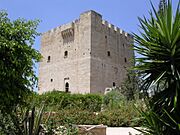
Limassol's history is well-known from events during the Third Crusade. In 1190, England's King Richard the Lionheart was traveling to the Holy Land. His fiancée, Berengaria, and sister, Joan, were on a different ship. A storm brought their ship to Limassol.
Isaac Komnenos, the ruler of Cyprus, wanted to capture them. He refused them fresh water. When Richard arrived, he asked Isaac to help the crusade. Isaac first agreed, then refused. Richard captured him, and the Anglo-Normans took over the island. Richard married Berengaria in Cyprus. He also destroyed Amathus and moved its people to Limassol.
In 1191, Cyprus was sold to the Templars. These were rich monk-soldiers who protected the Holy Sepulchre in Jerusalem. They charged high taxes, which made Cypriots revolt. Richard then sold Cyprus to Guy of Lusignan. This started the medieval Kingdom of Cyprus.
For about 300 years (1192–1489), Limassol thrived. Its harbor was a busy center for trade. This helped the city grow financially and culturally.
Venetian Control
In 1489, Cyprus was sold to Venice by Queen Catherine Cornaro. The Venetians mostly wanted taxes and resources from the island. Many people were forced to give a third of their income. Travelers in the 16th century noted the poor conditions of the people.
In 1538, the Ottomans captured Limassol and its castle. The Venetian governor later recaptured it. He decided to destroy the castle to prevent it from being taken again. This was finished by 1568. Two years later, the Ottomans captured the city again.
Ottoman Rule

The Ottoman Empire took over Cyprus in 1570. Limassol was captured in July 1570 without a fight. After the Ottomans took control, they rebuilt parts of the Limassol castle. The new fort was finished in 1590. Its underground and first floors became prison cells until 1950.
Some areas of the city were mostly Greek, and others were Turkish. Christians lived in small houses. This was to prevent Turks from riding horses inside. During Ottoman rule, Cyprus generally declined. There was little development. High taxes and oppression made it hard for children to get an education.
The church played a big role in educating Greeks from 1754–1821. Many new schools opened, especially in Limassol. The Greek School (now Laniteio Lyceum) was very important. Students learned Greek history, Turkish, and French.
British Colony
In 1878, the British took control of Cyprus. The first British governor of Limassol was Colonel Warren. He greatly improved the town. Roads were cleaned and fixed, trees were planted, and docks were built. Lanterns were installed for lighting in the 1880s. In 1912, electricity replaced the lanterns.
Early in the British rule, a post office, telegraph office, and hospital opened. In 1880, the first printing press started. Newspapers like Alithia and Anagennisis were printed there in 1897.
By the late 1800s, the first hotels opened. These changes helped Limassol's cultural life grow. Schools, theaters, clubs, art galleries, music halls, and sports clubs were all set up.
Modern Day Limassol
After the Turkish invasion of Cyprus in 1974, many Turkish Cypriot residents moved north. At the same time, many Greek Cypriots who became refugees settled in Limassol. When Famagusta was occupied, Limassol grew very quickly. This was due to the large number of new residents needing homes.
Many luxury hotels, restaurants, and entertainment places were built. Limassol became the new main business center of Cyprus. This role used to belong to Famagusta.
Today, Limassol is the second largest city in Cyprus. It has the island’s main port. It is famous for its exciting yearly events. These events bring many visitors from Cyprus and around the world.
City Layout
Areas and Neighborhoods
The Limassol urban area includes the Limassol Municipality and other municipalities. These are Kato Polemidia, Mesa Geitonia, Agios Athanasios, Germasogeia, and Ypsonas. For managing the city, Limassol's municipalities are divided into smaller areas called quarters. Ypsonas is an exception and is not divided this way.
Limassol's Climate
Limassol has a hot-summer Mediterranean climate. This means it has hot, dry summers and mild, wet winters. Short springs and autumns are generally warm and sunny.
From December to March, the weather can be rainy and windy. Sunshine lasts about 6 hours a day. Temperatures usually range from 16°C to 20°C during the day. Nights are cooler, from 7°C to 12°C. Rain can be heavy, and thunderstorms happen often but don't last long.
Snow in Limassol is very rare. It usually falls mixed with rain every 7 to 13 years. In January 2022, Limassol had a record low temperature of -0.8°C.
In spring, the weather is mild and pleasant. It is sunny almost every day. Temperatures are around 19-20°C during the day and 9°C at night. Rain showers and thunderstorms are common, especially in March and April. Sometimes, dust from the Sahara desert can make the air quality poor.
Summer is the longest season, lasting about six months from May to October. It is sunny every day, and rain is rare. Temperatures range from 19°C to 30°C in June and September. In July and August, they can reach 22°C to 40°C. Sea mist can sometimes occur in June, but it usually clears early.
Autumn is warm and sunny. It starts in late November and lasts into December. Temperatures range from 12°C to 20°C. The weather can vary. It might be very wet with strong thunderstorms, or very dry. Limassol gets about 410 mm of rain each year. Hail is rare and usually falls between October and April.
| Climate data for Limassol (1991–2005) | |||||||||||||
|---|---|---|---|---|---|---|---|---|---|---|---|---|---|
| Month | Jan | Feb | Mar | Apr | May | Jun | Jul | Aug | Sep | Oct | Nov | Dec | Year |
| Record high °C (°F) | 23.3 (73.9) |
24.4 (75.9) |
29.0 (84.2) |
33.6 (92.5) |
38.6 (101.5) |
40.3 (104.5) |
38.8 (101.8) |
40.2 (104.4) |
39.3 (102.7) |
35.6 (96.1) |
32.5 (90.5) |
24.6 (76.3) |
40.3 (104.5) |
| Mean daily maximum °C (°F) | 17.6 (63.7) |
17.8 (64.0) |
20.0 (68.0) |
22.9 (73.2) |
26.9 (80.4) |
30.8 (87.4) |
33.2 (91.8) |
33.3 (91.9) |
31.3 (88.3) |
28.6 (83.5) |
23.5 (74.3) |
18.9 (66.0) |
25.4 (77.7) |
| Daily mean °C (°F) | 13.2 (55.8) |
13.5 (56.3) |
15.2 (59.4) |
18.0 (64.4) |
21.8 (71.2) |
25.5 (77.9) |
27.8 (82.0) |
28.0 (82.4) |
26.0 (78.8) |
23.2 (73.8) |
18.5 (65.3) |
14.5 (58.1) |
20.4 (68.8) |
| Mean daily minimum °C (°F) | 8.8 (47.8) |
8.5 (47.3) |
10.4 (50.7) |
13.1 (55.6) |
16.7 (62.1) |
20.1 (68.2) |
22.4 (72.3) |
22.7 (72.9) |
20.6 (69.1) |
17.7 (63.9) |
13.5 (56.3) |
10.1 (50.2) |
15.4 (59.7) |
| Record low °C (°F) | −0.8 (30.6) |
1.0 (33.8) |
3.4 (38.1) |
5.0 (41.0) |
11.1 (52.0) |
13.9 (57.0) |
19.0 (66.2) |
18.9 (66.0) |
13.8 (56.8) |
8.8 (47.8) |
3.8 (38.8) |
0.5 (32.9) |
−0.8 (30.6) |
| Average rainfall mm (inches) | 86.7 (3.41) |
66.9 (2.63) |
35.8 (1.41) |
18.4 (0.72) |
5.1 (0.20) |
1.4 (0.06) |
0.0 (0.0) |
0.0 (0.0) |
2.9 (0.11) |
13.1 (0.52) |
77.5 (3.05) |
99.7 (3.93) |
407.5 (16.04) |
| Average rainy days (≥ 1 mm) | 9.3 | 7.1 | 5.6 | 3.3 | 1.1 | 0.2 | 0.0 | 0.0 | 0.3 | 1.9 | 5.5 | 8.8 | 43.1 |
| Mean monthly sunshine hours | 195.3 | 211.7 | 244.9 | 270.0 | 344.1 | 381.0 | 390.6 | 365.8 | 315.0 | 285.2 | 225.0 | 186.0 | 3,414.6 |
| Average ultraviolet index | 3 | 4 | 6 | 8 | 10 | 11 | 11 | 10 | 8 | 6 | 4 | 3 | 7 |
| Source: Meteorological Service (Cyprus) | |||||||||||||
| Jan | Feb | Mar | Apr | May | Jun | Jul | Aug | Sep | Oct | Nov | Dec | Year |
|---|---|---|---|---|---|---|---|---|---|---|---|---|
| 17.8 °C (64.0 °F) |
17.0 °C (62.6 °F) |
17.3 °C (63.1 °F) |
18.1 °C (64.6 °F) |
20.8 °C (69.4 °F) |
24.4 °C (75.9 °F) |
27.2 °C (81.0 °F) |
28.0 °C (82.4 °F) |
27.2 °C (81.0 °F) |
25.2 °C (77.4 °F) |
22.1 °C (71.8 °F) |
19.6 °C (67.3 °F) |
22.0 °C (71.6 °F) |
Who Lives in Limassol?
Limassol is the second most populated district in Cyprus. It had 198,558 residents in 2021. In 2021, 77.7% of the district's people were Cypriot citizens. About 8.6% were EU citizens, and 13.1% were foreign citizens.
Since the 1960s, more people have moved to Limassol. This includes people who were displaced after the 1974 invasion. This has greatly increased the city's population.
Limassol has a large community of Pontic Greeks. They came to Cyprus after the Soviet Union broke apart. The city is also popular with Russian and other people from former Soviet countries. Because of this, it is sometimes called “Limassolgrad.” Today, about 17% of Limassol’s population speaks Russian. About 8% are Russian citizens.
A Look at Past Populations
Historically, Limassol had a mix of Greek Cypriots, Turkish Cypriots, and Armenian Cypriots. Most Turkish Cypriots moved to the north in 1974-1975. Many Greek Cypriots from the north then settled in Limassol.
In the 1990s, some Cypriot Romani people returned to Limassol's Turkish area. Armenians stayed in Limassol. They live around the Sourp Kevork Armenian Apostolic Church. They also keep the Nareg Armenian School. There is also an Armenian village called Armenochori in the Limassol district.
The population grew a lot between 1878 and 1960. The number of residents went from 6,131 in 1881 to 43,593 in 1960.
Learning in Limassol
Limassol has many schools for all ages. There are over a hundred public schools. Most teaching is in Greek. Laniteio Lyceum is the oldest and largest high school in the city. It started in 1819 as the "Greek School." It was very important for education when there were not many public schools.
Recently, Limassol has become a big center for private and international high schools. The city has sixteen private high schools. They teach in English, Greek, Russian, Ukrainian, French, and other languages. Some well-known schools are The Grammar School, Foley’s School, The Heritage Private School, and American Academy.
These schools offer different learning programs. These include the British curriculum (IGCSE/A-Levels) and the International Baccalaureate (IB). They also offer Waldorf education and Montessori programs.
New school campuses are being built or planned. Pascal International Education is adding two new campuses in Limassol. One will offer the IB Diploma Programme starting in 2025. The Island Private School is adding a place for students to live. In 2025, a new Jewish educational campus is expected to start building. It will be a large international school for up to 1,500 students.
The Nareg Armenian School also has a campus in the city. Saint Mary's School is a Catholic school founded in 1923. It teaches students of all religions. It focuses on modern languages like English, Greek, French, and Italian.
For higher education, Limassol has the Cyprus University of Technology (CUT). This is one of three state universities. It was started in 2004. Limassol also has Frederick University and the University of Limassol. These are both private universities.
Limassol's Economy
Tourism in Limassol grew a lot after 1974. This was when Famagusta and Kyrenia, which were the main tourist spots, were occupied. Limassol has many beaches perfect for sunbathing and swimming. There is a beach in the Dasoudi area with all the needed facilities.
In 1974, the Port of Limassol became the main seaport for the Republic of Cyprus. Before that, the port of Famagusta was the main one.
Limassol is home to many of Cyprus’s wine companies. These companies use grapes from the southern Troodos Mountains. Companies like KEO, LOEL, SODAP, and ETKO make award-winning wines and brandies. These products are popular with locals and tourists. Many are also sent to Europe.
Limassol is the biggest industrial center in the district. It has about 350 industrial units. These make things like clothes, furniture, shoes, drinks, food, and metal items.
Limassol is a key trade center in Cyprus. This is partly because of the UK sovereign base nearby. The main markets are in the city center and the tourist area along the coast. This area has most of the hotels, restaurants, and entertainment places. Big global shops are on Anexartisias Street and Makariou Avenue. MYMALL is the largest mall in the district.
Limassol has two ports: the Old Port (Limassol Marina) and the New Port (Port of Limassol). The New Port handles most commercial and passenger ships. It is one of the busiest ports in the Mediterranean. It can hold about ten ships. The Old Port is smaller and mostly used by fishing boats. These ports help export grapes, wines, and citrus fruits. They also import cereals, vehicles, and other goods.
The Limassol Marina was built in 2014. It is near the Limassol Castle. This new area allows large yachts to dock. It can hold 1,000 boats.
Since 2014, Limassol has seen a lot of new construction. This is because of tourism and foreign investments. Public projects, like the Limassol Molos promenade, have made the city better. New highway flyovers and roundabouts have helped with traffic.
Limassol is now a major center for tourism, trade, and services. The city has many museums and archaeological sites. It attracts many tourists, especially during the long summer. There are many hotels and apartments for visitors.
The Limassol coastline, called “The Limassol Riviera,” is growing fast. New laws in 2013 encouraged building. Hundreds of new homes and businesses are added each year. As of 2024, over 70 buildings taller than 50m are planned or being built. This includes 32 skyscrapers. One of these is “ONE,” Cyprus’s tallest tower. It is also Europe’s tallest residential building by the sea. Another big project is the “City of Dreams Mediterranean (CoDM).” This is the first and largest integrated resort in Europe. In 2023, CoDM won an award for “Best New Luxury Casino Resort in the World.”
Places to See
Ancient Sites
Amathus
Amathus is an ancient city-kingdom. It is about 11 km east of Limassol. It dates back to 1100 BC. It has a rich history with influences from many cultures. The most famous ruin is the Temple of Aphrodite. This was a major place of worship. Many tombs from the Iron Age can be found there. There are also remains of public baths and other buildings. A large limestone amphora from Amathus is now in the Louvre Museum in Paris. This vase is from the 6th century BC and weighs 14 tonnes.
Kourion
Kourion is another ancient city-kingdom. It is about 19 km west of Limassol. It has a long history from the Neolithic period. It grew a lot during the Hellenistic, Roman, and Early Christian times. The main part of Kourion is the Greco-Roman theatre. It was built in the 2nd century BC and made bigger in the 2nd century AD. It has been fixed up and is still used for outdoor shows. It overlooks the Mediterranean Sea. The Sanctuary of Apollo Hylates was for Apollo Hylates, the god of the woodland. It has remains of a temple, baths, and a wrestling school.
Museums to Explore
The medieval Limassol Castle is one of ten castles in Cyprus. It was built by the Byzantines around 1000 AD. A chapel was also built there. It is believed that Richard the Lionheart married Princess Berengaria of Navarre here in 1191. The castle was a prison from 1790 to 1940. Now, it is a medieval museum. The museum shows items from 400 to 1870 AD. These include cannons, wood carvings, paintings, and tombstones.
The Kolossi Castle is about 11 km west of Limassol. It is a medieval fortress. The Knights of the Order of St. John of Jerusalem built it in the 13th century. The current building was rebuilt in 1454. It has a well-kept three-story tower. The castle was important for making sugar from sugarcane. It is also linked to the famous Commandaria wine.
The Folk Art Museum is in a historic house. It has a collection of Cypriot folk art from the last two centuries. This includes national costumes, tapestries, and embroidery. It also has wooden chests, jackets, and rural tools. The museum opened in 1985 and has over 500 items in six rooms. It won the Europa Nostra prize in 1989. Visitors can learn about Cypriot culture through these handmade items.
The Archaeological Museum has old items found in the district. These range from the Neolithic Age to the Roman period. You can see stone axes, pottery from Kourion and Amathus, and Roman terracottas. There are also gold jewelry, coins, sculptures, and marble statues. The museum used to be in Limassol Castle. It is now near the Public Gardens.
Since 2024, the non-profit PSI Foundation has a space in an old carob warehouse. It shows modern and contemporary art. It also features Cyprus's history. The first exhibition was about the 50th anniversary of the invasion. It was called “Casts of an Island 2024.” It was named “Cultural Event of the Year.”
Green Spaces
The Limassol Public Gardens are along the coast. They have many different plants, like eucalyptus and pine trees. Inside the garden, you can find the Limassol Zoo. It has deer, moufflons, ostriches, pheasants, tigers, lions, and monkeys. You can also see vultures, pelicans, and flamingos. The Patticheio Municipal Museum is also in the gardens. There is an open theater that hosts international shows.
The Limassol Molos is a large seaside park. It was built on reclaimed land and is about 1 km long. It is one of the city's most popular spots. You can go Fishing, kayaking, and do other watersports from its piers. The Limassol Sculpture Park is also at Molos. It has sculptures by many artists.
Limassol's Culture
Fun Festivals
Limassol is famous for its lively festivals. The most well-known are the Carnival and Wine Festival. The Limassol Carnival lasts ten days. It is full of fun masquerades. Its roots go back to old pagan traditions. Now, it is a popular entertainment event.
The carnival starts with a parade for the King (or Queen) Carnival. Then, there is a children’s fancy-dress competition. The Grand Carnival parade on Makariou Avenue draws huge crowds. People come to see the floats, serenades, and costumed groups. Many hotels host fancy-dress parties every night.
In early October, the big Wine Festival of Cyprus happens. It is held in the Limassol Public Gardens every evening. Visitors can try some of the best Cypriot wines for free. The festival also has folk dancing from Cyprus and other countries. There are also choir performances and other fun shows.
Other festivals in Limassol include the Limassol Street Life Festival and the Flower Festival (Anthestiria) in May. There is also the Flood Festival (Kataklysmos) and Shakespeare Festival in June. The Festival of Ancient Greek Drama is also held here.
Limassol also started its first Beer Festival in July 2003. This three-day festival is by the sea in the city center. It offers many Cypriot and imported beers. Entry is free, and beers are sold at low prices. There is also a mix of international music.
Limassol hosted the sixth Junior Eurovision Song Contest at the Spyros Kyprianou Athletic Centre.
Sports in Limassol
The Alphamega Stadium, also known as the Limassol Stadium, is the second largest football-only stadium on the island. It can hold 11,000 people. It is home to the city’s three main football clubs: AEL FC, Apollon FC, and Aris FC. AEL FC and Apollon FC are the biggest sports clubs in Limassol. They have football, basketball, and volleyball teams. All three football teams play in the top league, the First Division. AEL FC and Aris FC were among the first members of the Cyprus Football Association (CFA). There are also many other teams for athletics, bowling, cycling, and other sports.
The Tsirio Stadium can hold 13,331 people. It used to be the home stadium for Limassol's three football teams. It was also used by the Cyprus national football team. It is still used for athletics.
The Apollon Limassol Basketball Stadium hosted the 2003 FIBA Europe South Regional Challenge Cup Final Four. The Apollon BC and the AEL BC played there. AEL BC became the first Cypriot sports team to win a European trophy. In 2006, Limassol hosted the FIBA Europe All Star Game at the Spyros Kiprianou Sports Centre. The Cyprus Rally was also held in the Limassol district. In 2025, Limassol will host the EuroBasket.
The Limassol Marathon is an annual race series. It started in 2006. In 2024, over 17,000 runners from more than 70 countries took part. There are different races, including a full marathon, a half marathon, a 10 km Energy Race, a 5 km Corporate Race, and a 1 km Youth Race.
Limassol also has a rugby union team, the Limassol Crusaders. They play at the AEK Achileas Stadium. There is a professional handball team, APEN Agiou Athanasiou.
Rowing and canoeing are becoming very popular in Limassol. This is thanks to the three nautical clubs in the city. The Germasoyia dam is used for both practice and competitions.
Getting Around Limassol
Limassol is a major transportation hub on the island. The city has the largest port in Cyprus. This port handles almost all passenger traffic coming to and leaving the island.
Bus Travel
EMEL (Limassol Passenger Transport Company) is the main bus operator in Limassol. As of 2024, its network has about 53 bus lines. These lines cover the Limassol district. The company has about 150 buses, and 35 of them are electric. Buses for national and regional travel are provided by InterCity Buses. They leave from the Limassol Port passenger building.
Ferry Services
The Port of Limassol is the largest port in Cyprus. Commercial and passenger cruise ships often stop here.
Main Roads
The city is a highway center. The following motorways cross through Limassol:
- A1 motorway goes north to Nicosia.
- A5 motorway goes east to Larnaca and Famagusta.
- A6 motorway goes west to Paphos.
- A8 motorway goes north to Saittas village (still being built as of 2024).
Airports Nearby
Limassol does not have its own airport. However, it is close to two international airports. Larnaca International Airport is about 60 km northeast of the city. Paphos International Airport is about 50 km northwest. Bus services connect both airports to the city. Limassol Airport Express serves these routes from Chavouzas station.
How Limassol is Governed
City Politics
The first Marxist groups in Cyprus started in Limassol in the early 1920s. In 1926, the Communist party of Cyprus was formed there. Its later party, Progressive Party of Working People (AKEL), has won most city elections since 1943.
The European People's Party held a special meeting in Limassol in 2013. Important leaders from the European Council, governments, and the European Commission attended. They discussed the EU's financial plans for 2014–2020. They also prepared for the 2014 European elections.
Andreas Christou, an AKEL member, was re-elected mayor of Limassol in December 2011. He served his second five-year term.
Limassol's Global Connections
Sister Cities
Limassol is twinned with these cities:
 Rhodes, Greece (since 1970)
Rhodes, Greece (since 1970) Alexandria, Egypt (since 1972)
Alexandria, Egypt (since 1972) Thessaloniki, Greece (since 1984)
Thessaloniki, Greece (since 1984) Ioannina, Greece (since 1984)
Ioannina, Greece (since 1984) Heraklion, Greece (since 1989)
Heraklion, Greece (since 1989) Niederkassel, Germany (since 1989)
Niederkassel, Germany (since 1989) Marseille, France (since 1992)
Marseille, France (since 1992) Nanjing, China (since 1992)
Nanjing, China (since 1992) Zakynthos, Greece (since 1998)
Zakynthos, Greece (since 1998) Haifa, Israel (since 2000)
Haifa, Israel (since 2000) Patras, Greece (since 2001)
Patras, Greece (since 2001)
Consulates in Limassol
As of October 2024, Limassol hosts 6 consulates general and 33 consulates.
 Armenia
Armenia Belgium
Belgium Botswana
Botswana Cape Verde
Cape Verde Colombia
Colombia Côte d'Ivoire
Côte d'Ivoire Ecuador
Ecuador France
France Georgia
Georgia Israel
Israel Italy
Italy Latvia
Latvia Lesotho
Lesotho Liberia (consulate general)
Liberia (consulate general) Malta (consulate general)
Malta (consulate general) Mauritius
Mauritius Moldova
Moldova Montenegro
Montenegro Netherlands
Netherlands Nicaragua (consulate general)
Nicaragua (consulate general) Pakistan
Pakistan Palau
Palau Poland (consulate general)
Poland (consulate general) Portugal
Portugal Romania
Romania Saint Lucia
Saint Lucia Samoa
Samoa Senegal
Senegal Sierra Leone (consulate general)
Sierra Leone (consulate general) Slovakia
Slovakia Slovenia (consulate general)
Slovenia (consulate general) Tanzania
Tanzania Togo
Togo Ukraine
Ukraine Vietnam
Vietnam Yemen
Yemen Zambia
Zambia
Famous People from Limassol
See also
 In Spanish: Limasol para niños
In Spanish: Limasol para niños
- Amathus
- Cyprus University of Technology
- Kourion
- Laniteio Lyceum
- Limassol Castle
- Limassol District
- Molos Promenade
- Municipalities in Cyprus
- Shopping malls in Cyprus
- Tallest buildings in Cyprus
- My Mall Limassol
- Port of Limassol


